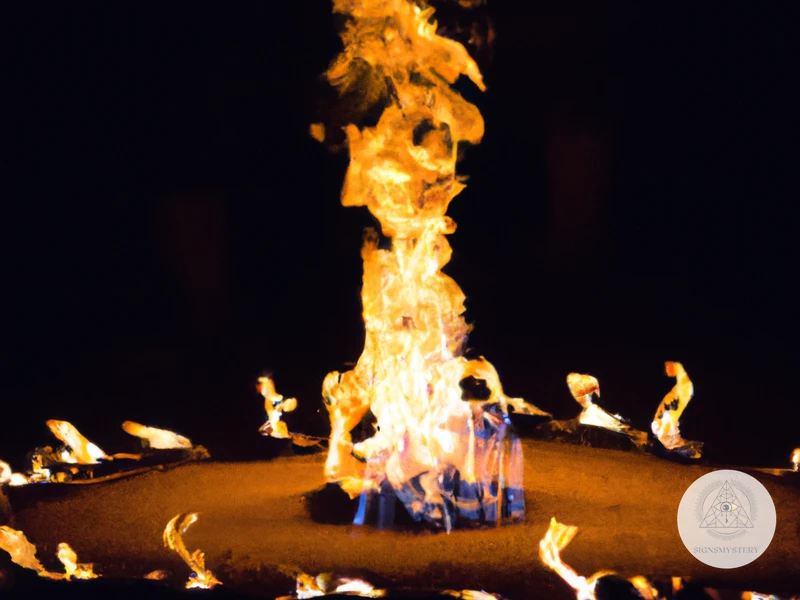Fire has been a powerful force in human history, providing warmth, light, energy, and a means of cooking food. But in shamanism, fire takes on a deeper significance as a source of power and transformation. For shamans, fire is not just a physical phenomenon, but a spiritual one as well. In this article, we will explore the role of fire in shamanism, its symbolism, and the practice of fire ceremonies. By delving into the spiritual significance of fire and how it can be harnessed for healing and transformation, we can gain a greater understanding of the power of the natural world and our place within it.
The Role of Fire in Shamanism

Fire has a significant role in shamanism as it serves as a source of power and transformation during ceremonies. The spiritual significance of fire is rooted in its ability to purify and renew, which is why it is often used as a tool for healing and releasing negative energy. In fire ceremonies, shamans and participants interact with fire through offerings and dance, creating a powerful connection between themselves and the element. The symbolism of fire also represents both heat and light, which reflects transformation and enlightenment. With its transformative power, fire is viewed as a purifier that can help bring balance and harmony into one’s life. By participating in various types of fire ceremonies, individuals can benefit from the healing and spiritual renewal that comes with connecting with fire. (Link to /healing-power-of-fire-ceremonies/)
The Spiritual Significance of Fire
Fire has been a powerful symbol in shamanism for centuries. It is believed that spiritual energy exists within all things, and fire is no exception. In fact, fire is often seen as a direct manifestation of the divine energy that permeates the universe. The spiritual significance of fire in shamanism can be seen in many rituals and ceremonies.
Fire is often used as a means of communicating with the spirit world. Many shamans believe that fire acts as a conduit between the physical and spiritual realms, and that by communing with fire, they can connect with the spirits. Fire is also seen as a symbol of transformation and enlightenment. It is believed that by observing the flames and entering into a state of meditation, one can achieve a higher level of consciousness and unlock the secrets of the universe.
When used in ceremonies, fire is often seen as a symbol of purification and release. It is believed that the flames have the power to burn away negative energy and purify the soul. Shamans often use fire to release negative emotions or traumas that are holding them back. By casting these emotions into the flames, they believe they can free themselves from the past and move forward with a renewed sense of purpose.
In many shamanic traditions, fire is also associated with the sun. Just as the sun brings light and warmth to the world, fire is seen as a source of warmth, light, and life-giving energy. By harnessing the power of fire, shamans believe they can tap into the life-giving force of the sun and bring balance and harmony to the world.
The spiritual significance of fire in shamanism is multifaceted. It represents transformation, purification, and a connection to the spiritual realm. It is believed that by working with fire and incorporating it into ceremonies, shamans can access deeper levels of understanding and unlock the secrets of the universe. Whether used as a tool for healing, purification, or spiritual growth, fire remains an important part of shamanic practice.
Fire ceremonies are a powerful way to connect with the spiritual energy of fire and unlock its transformative power. By setting clear intentions and following specific rituals, participants in fire ceremonies can experience deep spiritual renewal and transformation. Alternatively, shamanic fire ceremonies can take many forms in different cultures and traditions, each with their own unique meanings and practices. Music and dance often play a key role in many fire ceremonies, helping to create an atmosphere of spiritual energy and connection.
Interacting with Fire in Ceremonies
Interacting with fire in ceremonies is considered one of the essential practices in shamanism. Fire, as a source of light, energy, and heat, is believed to have potent spiritual energy that can help connect the practitioner with the spirit world. Here are several ways shaman interact with fire in ceremonies:
| Dancing with Fire | Fire Gazing | Fire Breathing |
|---|---|---|
| Dancing around the fire is a common practice in shamanic traditions. It is believed that through the dance, the practitioner attains a trance state and connects with the spirits. | Gazing at the fire is another way of interacting with it. By focusing on the flames, the practitioner attains a meditative state and receives insights and guidance from the spirits. | Fire breathing is a breathing technique used by the shaman to increase their vital energy and connect with the spirits. By breathing in and out in a rhythmic pattern, the practitioner attains an altered state of consciousness and enters the spirit world. |
These techniques allow the shaman to enter an altered state of consciousness, where they can communicate with the spirits and access profound revelations. Fire ceremonies are often accompanied by the use of additional tools like rattles, drums, or music to deepen the experience.
Fire ceremonies contribute significantly to personal growth, and they are used as a healing approach by shamans. Fire can be seen as a metaphor for the releasing of negative emotions and welcoming new growth. In this way, fire ceremonies enable individuals to meet their challenges, overcome their fears, and open their hearts to new beginnings.
If you want to learn more about music and dance in fire ceremonies, read this article: Music and Dance in Fire Ceremonies.
The Symbolism of Fire in Shamanism
Fire has deep symbolic significance in shamanism, representing a source of power and transformation. In shamanic tradition, fire is associated with the transformative power of the sun and is seen as a catalyst for change and rebirth. Fire is also closely linked to the elements of heat and light. The heat of fire is seen as a source of purification, and the light of fire is seen as a symbol of spiritual illumination and enlightenment. In ceremonies, fire is often used to represent the sacred, and its flames are believed to connect the spiritual and physical realms. The transformative power of fire is also believed to help release negative energy and emotions, allowing individuals to experience spiritual renewal and connection. Whether used in healing ceremonies or for personal spiritual transformation, the symbolic role of fire in shamanism is a powerful force for change and renewal.
The Elements of Fire: Heat and Light
When it comes to fire in shamanism, two of its most significant elements are heat and light. These elements both play integral roles in fire ceremonies and other shamanic practices. Let’s take a closer look at each one and its significance in shamanism.
Heat
The heat produced by fire is a powerful symbol in many cultures, often representing transformation and change. In shamanism, heat is believed to be a purifying force that can cleanse the body, mind, and spirit of negative energies. When participating in a fire ceremony, individuals may feel the intense heat of the flames and use it as a way to release any emotional or mental blockages they may be holding onto.
Beyond its purifying role, heat can also be a source of physical healing. Substances like herbs and oils can be added to the fire to create smoke that can be inhaled, helping to relieve respiratory issues and promote overall wellness.
Light
Light is another essential element of fire in shamanism. Fire illuminates even the darkest spaces, providing clarity and insight. In ceremonies, the light of the flames can help participants to see things in a new way, gaining new perspectives on their lives and spiritual journeys.
Additionally, firelight can be used as a tool for divination. Shamans may “read” the flames for messages and guidance from the spiritual realm. The way the flames dance and flicker can reveal hidden truths and offer answers to important questions.
In shamanic culture, fire is much more than just a tool for warmth and cooking. Its elements of heat and light hold immense power for transformation, purification, healing, and insight. By harnessing the energy of fire in ceremonies and other practices, individuals can connect more deeply with themselves and the spiritual world around them.
The Transformative Power of Fire
The transformative power of fire in shamanism is one of the most significant aspects of this ancient practice. Fire is considered a living element, a powerful symbol of transformation and regeneration. It has the ability to purify and transform the energy in any space, both physically and metaphysically. In shamanic traditions, fire ceremonies are especially effective in transforming stagnant or negative energy, bringing a sense of renewal, and revitalizing the spirit.
Fire has always been considered a symbol of destruction and creation, death, and rebirth, making it a potent tool in shamanic rituals. It is believed that the heat and light generated from fire have healing properties, allowing us to release negative energy and patterns, and allowing space for positive energy and growth.
One way fire is used in shamanism is through the use of the sweat lodge, a ritual structure that requires the use of heated rocks to create steam and heat. This process is believed to wash away the toxins in the body and mind, allowing for spiritual purification and healing. The heat generated by the fire in the sweat lodge is used to open the pores of the skin, allowing for a deeper release of negative energy and stress.
Another way fire is used in shamanism is through the use of burning herbs and resins, such as sage, cedar, and frankincense. These substances are believed to have cleansing and purifying properties, and are burned to release their fragrance into the air, creating a sense of peace and positivity.
Fire is also used in shamanic journeying, where a fire is built to create a portal between the physical and spiritual realms. The fire is used as a focal point for meditation, allowing the shaman to journey to other worlds and connect with spirit guides and ancestors.
Fire has a powerful transformative power in shamanism. Its ability to purify and transform energy, release negative patterns, and allow space for growth and positivity makes it an essential tool in shamanic practices. Whether through the sweat lodge, burning herbs, or journeying, fire is an integral part of shamanic traditions, helping to heal and rejuvenate the spirit.
Fire as a Purifier
In shamanism, fire is considered a powerful purifying force. It is believed to cleanse negative energies and release stagnant emotions. Fire symbolizes transformation, and through the burning process, it transforms whatever is thrown into it into ashes, making space for new growth.
During fire ceremonies, participants often offer items to the flames that represent aspects of themselves or their lives they want to release or transform. These items can be physical objects, herbs, or even written intentions. As the items burn, the smoke carries their energy upwards, away from the participant, and disperses it into the universe.
The heat of the fire also helps to purify the body and mind. Heat can be used to relax tense muscles and release physical toxins from the body. It can also help to clear the mind and release negative thought patterns.
Fire as a purifier is also closely linked to the concept of sacrifice. The offering of items to the flames represents a sacrifice of the old in order to make way for the new. This act of sacrifice is seen as a way to connect with the divine and gain spiritual insight.
Fire as a purifier is an essential element in shamanic practice. It provides a powerful tool for releasing negative energy, purifying the body and mind, and connecting with the divine. By embracing the transformative power of fire, shamanic practitioners can experience profound personal growth and spiritual renewal.
The Practice of Fire Ceremonies

Fire ceremonies are an integral part of shamanism as they represent a connection to the spirit world. Preparing for a Fire Ceremony involves selecting a location and building a fire that is large enough to serve as the focal point for the ceremony. Symbolic objects and offerings are also prepared for the ceremony, such as feathers, tobacco, and crystals. During the ceremony, participants often engage in The Stages of a Fire Ceremony, which includes offerings, prayers, and meditation. Types of Fire Ceremonies can vary based on the purpose of the ceremony, such as to honor ancestors or to release negative energy. By connecting with the fire, participants can experience a sense of spiritual renewal and connection to the divine.
Preparing for a Fire Ceremony
Preparing for a fire ceremony is crucial as it sets the intention and tone for the entire experience. Here are several steps to help you prepare for a fire ceremony:
| Step 1: | Choose a location for the fire ceremony. It should be a safe and private space where you can connect with the elements and focus your energy. |
| Step 2: | Gather materials for the fire, including dry wood, kindling, and matches or a lighter. |
| Step 3: | Cleanse yourself and the space by smudging with sage or palo santo, or by using other purification methods like sound healing or crystals. |
| Step 4: | Set your intentions for the ceremony. This can be done through meditation, journaling, or simply speaking your intentions aloud. |
| Step 5: | Choose any additional elements you would like to incorporate into the ceremony, such as crystals, flowers, or other items that hold special meaning to you. |
| Step 6: | Prepare any offerings you would like to give to the fire, such as herbs, tobacco, or other items that hold symbolic value to you. |
It’s important to approach this process with an open mind and heart. Remember that the goal of the ceremony is to connect with the elements, your higher self, and any spirit guides or energies that may be present. By taking the time to prepare and set your intentions, you will be better able to fully immerse yourself in the experience and benefit from the transformative power of fire in shamanism.
The Stages of a Fire Ceremony
Fire ceremonies are an important spiritual practice in shamanism, and there are certain stages that are typically followed in these ceremonies. The first stage is preparation, where the space for the ceremony is cleared and the fire is built. During this stage, prayers and intentions may also be set, and participants may take part in a cleansing ritual.
Once the fire is lit, the initiation stage begins. This is where the shaman or ceremonial leader may call in the spirits and energies that they wish to work with. The participants may also
Subscribe to Our Newsletter
Sign up to receive the latest news and updates.
After the initiation stage, the transformation stage begins. This is where the real work of the ceremony takes place, and participants may be encouraged to focus their intentions and attention on the fire. As they do so, they may experience sensations of heat or tingling, or they may have visions or other spiritual experiences.
Once the transformation stage has reached its climax, the integration stage begins. This is where participants are invited to share their experiences and insights, and the shaman or ceremonial leader may offer guidance and support to help them make sense of what they have experienced.
Finally, the closing stage brings the ceremony to a close. This may involve a final prayer or invocation, and participants may be invited to offer gratitude for the experience. The fire may also be allowed to burn down naturally as a way of symbolizing the completion of the ceremony.
The stages of a fire ceremony follow a clear progression from preparation to initiation, transformation, integration, and finally, closure. By following this structure, participants can experience the full power and potential of the fire ceremony as a tool for spiritual growth and transformation.
Types of Fire Ceremonies
The use of fire in shamanic ceremonies is an ancient and powerful practice that has been passed down through generations. There are several types of Fire Ceremonies that are performed in shamanism to address different aspects of spiritual healing. Each type of ceremony has its unique set of rituals and practices.
One of the most common fire ceremonies in shamanism is the Fire Dance Ceremony. This ceremony involves dancing around a fire while wearing traditional ceremonial attire. The dance is meant to symbolize spiritual purification and renewal. It is believed that the fire serves as a cleanser, and the dancing helps the participants to release negative energy and emotions.
Another type of Fire Ceremony is the Fire Offering Ceremony which involves making offerings to the flames. These offerings can include herbs, candles, flowers, and other items that represent the intention of the ceremony. In this ceremony, the Shaman typically creates a sacred space around the fire and invokes the spirits to cleanse and purify the participants.
The Sweat Lodge Ceremony is another type of Fire Ceremony that involves entering a dome-shaped structure that is heated with hot stones. This ceremony is believed to have healing and purifying effects on the body and mind. Participants sit in the lodge while the Shaman chants and performs rituals, often with the use of fire.
The Vision Quest Ceremony is a type of Fire Ceremony that involves fasting and praying for a vision or guidance from the spirits. This ceremony can vary in length, with some participants fasting for multiple days. During this time, the participant sits near a small fire and meditates, seeking a spiritual vision that will guide them on their path.
Fire Ceremonies in shamanism are a powerful means of spiritual healing and renewal. They help to cleanse the mind, body, and spirit, and bring participants into a deeper connection with the natural world and the spirits that reside within it.
The Benefits of Fire in Shamanism
Fire has been used in shamanic practices for its powerful healing and transformative properties. The intense energy of fire can purify negative energies and emotions, clearing the way for spiritual growth. Fire ceremonies can also renew spiritual connections with oneself, others, and nature. The energy of fire can be harnessed to release stagnant energy, bringing balance and clarity to the mind, body, and spirit. Additionally, spiritual healing through fire can help individuals recover from physical injuries and illnesses. The benefits of fire in shamanism extend beyond individual healing as fire ceremonies can also strengthen the bonds of community, creating a shared experience that fosters connection and a sense of belonging.
Healing with Fire
In shamanism, fire is commonly used for healing purposes. Fire is believed to have a cleansing effect on the body, mind, and spirit. It is considered a powerful tool to restore balance and promote healing in a person’s life.
One of the ways fire is used in healing is through sweat lodges. These are small structures made from natural materials, such as wood and branches, designed to contain heat from hot stones. The stones are heated until they are red hot, then placed in the center of the structure where participants sit. This creates a sauna-like atmosphere, inducing intense sweating to help detoxify the body. The process also creates a sense of purity and emotional release, promoting spiritual and emotional healing.
Another way fire is used in healing is through the burning of specific herbs or resins. This practice is known as smudging. Herbs such as sage, sweetgrass, and cedar are burned, and the smoke is used to purify the air and the space around an individual. The smoke is believed to carry negative energies away, while simultaneously attracting positive energies and creating a healing balance.
Fire is also used to promote physical healing. Burn therapy, also known as moxibustion, is a practice where a small amount of herbal material is ignited and placed on the skin over an affected area. The heat from the fire is said to promote circulation and have a healing effect on sore muscles and joint pain.
The use of fire for healing is not limited to physical ailments. Fire is also used for emotional and mental healing. Fire ceremonies are often used to release negative emotions, habits, or energies. Participants may write down negative emotions or habits onto a piece of paper, and then throw it into the fire. This act symbolizes releasing the negative energy and inviting positive energy and transformation into their lives.
Fire is an important tool for healing in shamanism and is used in various ways to promote physical, emotional, and spiritual balance. From sweat lodges to smudging to burn therapy, fire has been a healing agent since ancient times, and continues to be a powerful tool for transformation and cleansing today.
Spiritual Renewal and Connection
Fire is often used in shamanism as a tool to bring about spiritual renewal and connection to the divine. The intense heat and light of the flames can help individuals release negative emotions and thoughts that may be holding them back. Through this process of releasing, spiritual growth and transformation can occur.
In fire ceremonies, individuals may offer prayers or intentions to the spirit of the fire, using it as a conduit to connect with the spiritual realm. The warmth and light of the flames can create a sense of comfort and safety, allowing individuals to open up to the deeper parts of themselves and the world around them.
Fire can be seen as a symbol of the divine, representing the spark of life and creativity within all beings. By working with fire in ceremony, individuals may cultivate a deeper connection to this divine energy and tap into their own inner fire, igniting their passion and purpose in life.
Fire can help individuals connect to their ancestors, who may have used fire in their own spiritual practices. By invoking the spirits of their ancestors through the use of fire, individuals may gain insight and wisdom into their own spiritual paths and ancestral lineages.
Working with fire in shamanic practice can bring about a profound sense of spiritual renewal and connection. The transformative power of the flames can help individuals release what no longer serves them and tap into their own inner fire, leading to greater clarity, purpose, and connection to the divine.
Conclusion
As we have seen throughout this article, fire holds a significant role in shamanism. It is not only a source of warmth and light, but also a powerful symbol of transformation and purification. Fire is a key element in shamanic ceremonies and practices, providing a means of connection with the spiritual realm and enabling deep healing and renewal.
Through our exploration of the spiritual significance of fire, we have gained insights into its power as a transformative force. Fire has the capacity to burn away old patterns and beliefs, opening us up to new perspectives and possibilities. Its energy can help us release emotional and psychological blocks, allowing us to move forward with greater clarity and purpose.
We have also examined the symbolism of fire, focusing on its two primary elements: heat and light. Heat represents the unconscious, instinctual aspects of the self, while light represents the conscious, rational aspects. When these elements are brought into balance within ourselves, we are able to harness the full potential of fire as a tool for personal growth and transformation.
In our discussion of fire ceremonies, we have explored the preparation, stages and different types of ceremonies that are commonly used in shamanic practice. Whether it is a simple home ritual or a larger community gathering, fire ceremonies can be highly effective ways to connect with the spiritual realm and to invoke the transformative power of fire in a safe and supportive setting.
Finally, we have considered the many benefits of fire in shamanism, from its ability to promote physical healing to its capacity for spiritual renewal and connection. Whether you are seeking deeper healing, greater personal growth, or simply a sense of connection with the spiritual realm, fire ceremonies and shamanic practices can offer powerful tools for achieving your goals.
In conclusion, fire is an essential element of shamanic practice, offering a source of power, transformation, and purification that can be tapped into by anyone with a willingness to explore its potential. By taking the time to honor the sacred nature of fire and to understand its deeper significance, we can unlock its full potential and access the transformative power that lies within.
Frequently Asked Questions
What is the significance of fire in shamanism?
Fire is considered an essential element in shamanic practices as it represents transformation, purification, and the source of life energy.
How does fire aid in spiritual transformation in ceremonies?
Fire serves as a conduit between the physical and spiritual world, helping individuals release negative energy, and transform into a new state of consciousness.
What is the spiritual significance of fire?
Fire is viewed in many shamanic traditions as a manifestation of the divine and used as a source of spiritual power and connection to the ancestors and spirits.
How does one interact with fire in shamanic ceremonies?
One can interact with fire by using it as an object of focus or by performing specific movements and gestures around it to connect with the spiritual realm.
What symbolism is associated with fire in shamanism?
Fire has a variety of symbolic meanings in shamanic practices, including heat and light, passion and transformation, and purification and destruction.
What is the transformative power of fire?
The transformative power of fire lies in its ability to burn away negative energy and facilitate spiritual growth. Fire brings clarity, illuminates the path to transformation, and helps individuals shed their old selves.
What are some benefits of fire ceremonies?
Fire ceremonies provide numerous benefits, including emotional release, greater connection to the spiritual realm, and deep healing on a physical, emotional, and spiritual level.
What are the different types of fire ceremonies?
There are many types of shamanic fire ceremonies, including firewalking, bonfires, sweat lodges, and candle offerings. Each ceremony has a unique purpose and can be tailored to meet individual or group needs.
How can one prepare for a fire ceremony?
Preparation for a fire ceremony involves setting intentions, creating a sacred space, gathering firewood and tools, and mentally and emotionally preparing for the transformative experience.
What are the benefits of healing with fire?
Healing with fire can help individuals release negative energy, heal emotional wounds, and restore balance to the body and mind. Fire is viewed as a powerful tool for both physical and spiritual healing.










